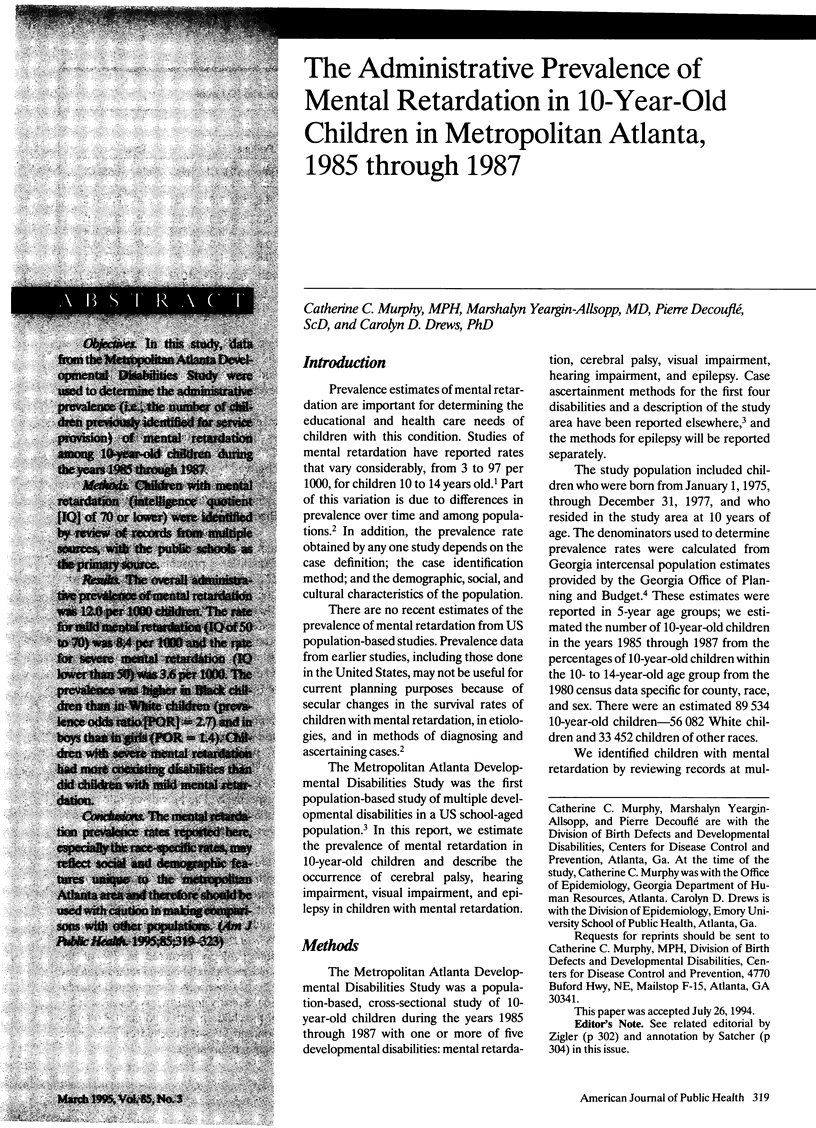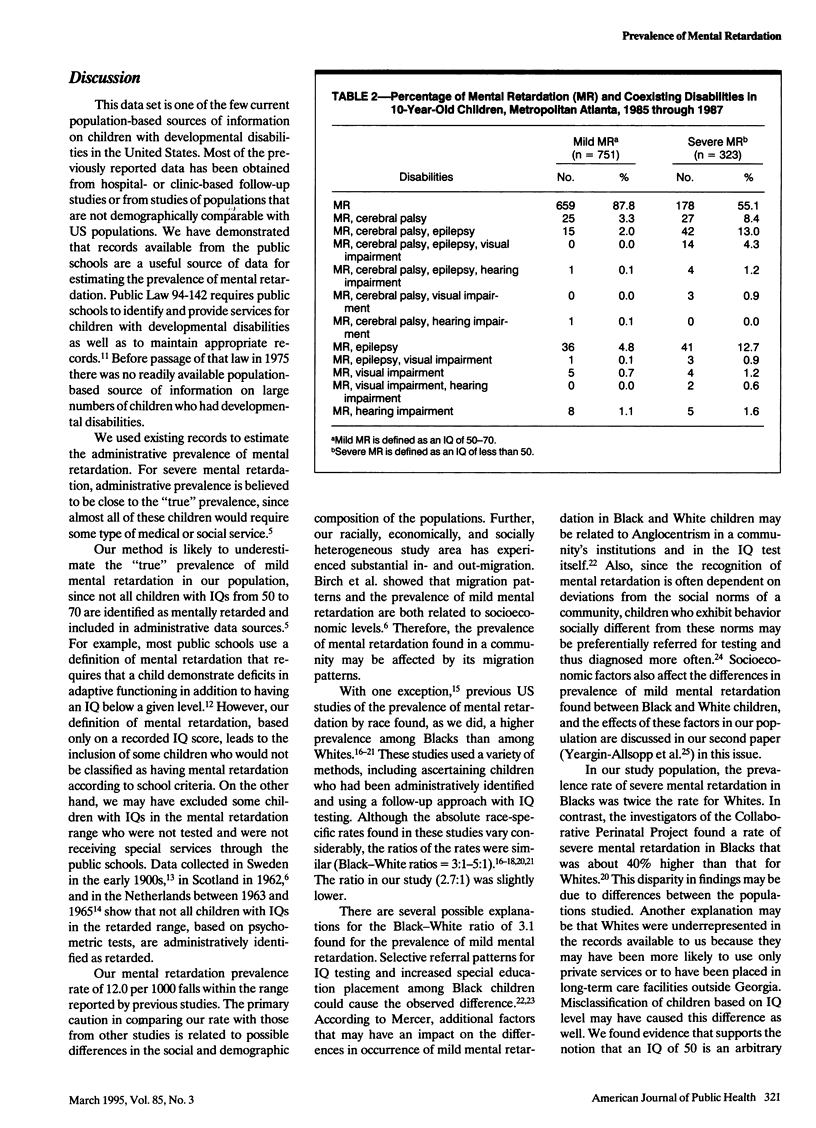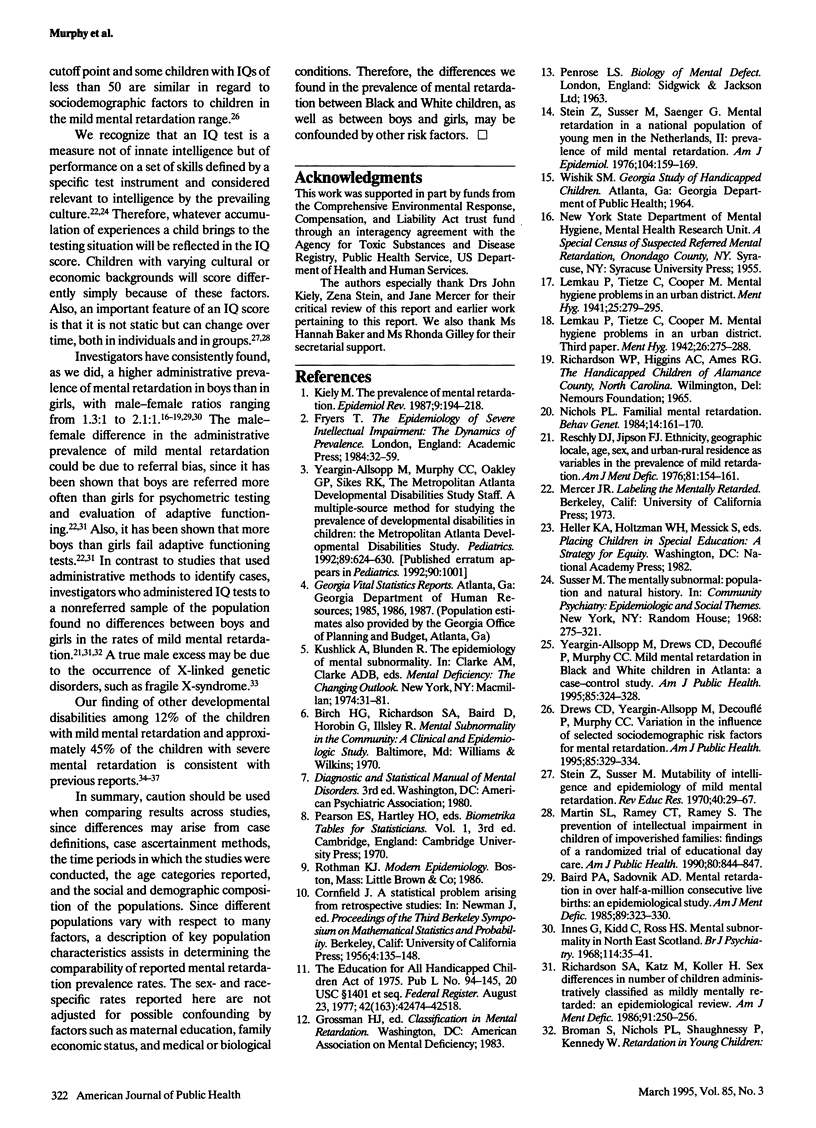Abstract
OBJECTIVES. In this study, data from the Metropolitan Atlanta Developmental Disabilities Study were used to determine the administrative prevalence (i.e., the number of children previously identified for service provision) of mental retardation among 10-year-old children during the years 1985 through 1987. METHODS. Children with mental retardation (intelligence quotient [IQ] of 70 or lower) were identified by review of records from multiple sources, with the public schools as the primary source. RESULTS. The overall administrative prevalence of mental retardation was 12.0 per 1000 children. The rate for mild mental retardation (IQ of 50 to 70) was 8.4 per 1000 and the rate for severe mental retardation (IQ lower than 50) was 3.6 per 1000. The prevalence was higher in Black children than in White children (prevalence odds ratio [POR] = 2.7) and in boys than in girls (POR = 1.4). Children with severe mental retardation had more coexisting disabilities than did children with mild mental retardation. CONCLUSIONS. The mental retardation prevalence rates reported here, especially the race-specific rates, may reflect social and demographic features unique to the metropolitan Atlanta area and therefore should be used with caution in making comparisons with other populations.
Full text
PDF




Selected References
These references are in PubMed. This may not be the complete list of references from this article.
- Baird P. A., Sadovnick A. D. Mental retardation in over half-a-million consecutive livebirths: an epidemiological study. Am J Ment Defic. 1985 Jan;89(4):323–330. [PubMed] [Google Scholar]
- Blomquist H. K., Gustavson K. H., Holmgren G. Mild mental retardation in children in a northern Swedish county. J Ment Defic Res. 1981 Sep;25(Pt 3):169–186. doi: 10.1111/j.1365-2788.1981.tb00107.x. [DOI] [PubMed] [Google Scholar]
- Drews C. D., Yeargin-Allsopp M., Decouflé P., Murphy C. C. Variation in the influence of selected sociodemographic risk factors for mental retardation. Am J Public Health. 1995 Mar;85(3):329–334. doi: 10.2105/ajph.85.3.329. [DOI] [PMC free article] [PubMed] [Google Scholar]
- Drillien C. M., Jameson S., Wilkinson E. M. Studies in mental handicap. I. Prevalence and distribution by clinical type and severity of defect. Arch Dis Child. 1966 Oct;41(219):528–538. doi: 10.1136/adc.41.219.528. [DOI] [PMC free article] [PubMed] [Google Scholar]
- Gustavson K. H., Hagberg B., Hagberg G., Sars K. Severe mental retardation in a Swedish county. II. Etiologic and pathogenetic aspects of children born 1959--1970. Neuropadiatrie. 1977 Aug;8(3):293–304. doi: 10.1055/s-0028-1091525. [DOI] [PubMed] [Google Scholar]
- Hagberg B., Hagberg G., Lewerth A., Lindberg U. Mild mental retardation in Swedish school children. II. Etiologic and pathogenetic aspects. Acta Paediatr Scand. 1981 Jul;70(4):445–452. doi: 10.1111/j.1651-2227.1981.tb05721.x. [DOI] [PubMed] [Google Scholar]
- Innes G., Kidd C., Ross H. S. Mental subnormality in North-East Scotland. Br J Psychiatry. 1968 Jan;114(506):35–41. doi: 10.1192/bjp.114.506.35. [DOI] [PubMed] [Google Scholar]
- Kiely M. The prevalence of mental retardation. Epidemiol Rev. 1987;9:194–218. doi: 10.1093/oxfordjournals.epirev.a036302. [DOI] [PubMed] [Google Scholar]
- Martin S. L., Ramey C. T., Ramey S. The prevention of intellectual impairment in children of impoverished families: findings of a randomized trial of educational day care. Am J Public Health. 1990 Jul;80(7):844–847. doi: 10.2105/ajph.80.7.844. [DOI] [PMC free article] [PubMed] [Google Scholar]
- Nichols P. L. Familial mental retardation. Behav Genet. 1984 May;14(3):161–170. doi: 10.1007/BF01065538. [DOI] [PubMed] [Google Scholar]
- Reschly D. J., Jipson F. J. Ethnicity, geographic locale, age, sex, and urban-rural residence as variables in the prevalence of mild retardation. Am J Ment Defic. 1976 Sep;81(2):154–161. [PubMed] [Google Scholar]
- Richardson S. A., Katz M., Koller H. Sex differences in number of children administratively classified as mildly mentally retarded: an epidemiological review. Am J Ment Defic. 1986 Nov;91(3):250–256. [PubMed] [Google Scholar]
- Stein Z., Susser M., Saenger G. Mental retardation in a national population of young men in the Netherlands. II. Prevalence of mild mental retardation. Am J Epidemiol. 1976 Aug;104(2):159–169. doi: 10.1093/oxfordjournals.aje.a112286. [DOI] [PubMed] [Google Scholar]
- Turner G., Opitz J. M. X-linked mental retardation. Am J Med Genet. 1980;7(4):407–415. doi: 10.1002/ajmg.1320070403. [DOI] [PubMed] [Google Scholar]
- Yeargin-Allsopp M., Drews C. D., Decouflé P., Murphy C. C. Mild mental retardation in black and white children in metropolitan Atlanta: a case-control study. Am J Public Health. 1995 Mar;85(3):324–328. doi: 10.2105/ajph.85.3.324. [DOI] [PMC free article] [PubMed] [Google Scholar]
- Yeargin-Allsopp M., Murphy C. C., Oakley G. P., Sikes R. K. A multiple-source method for studying the prevalence of developmental disabilities in children: the Metropolitan Atlanta Developmental Disabilities Study. Pediatrics. 1992 Apr;89(4 Pt 1):624–630. [PubMed] [Google Scholar]


